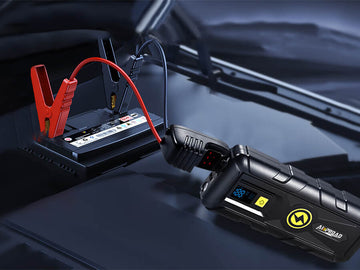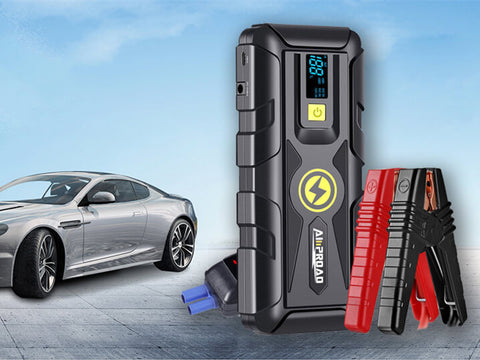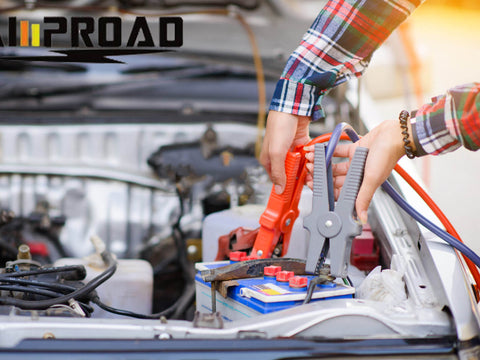
Are you stranded with a dead battery and wondering who to call for a jump start? Whether it's a roadside assistance service, a nearby auto shop, or a helpful passerby, having a plan can make all the difference in getting back on the road quickly. A jump start provides the necessary power to revive a dead battery, but safety and proper procedure are key. Knowing the right steps and resources available ensures a smooth and hassle-free experience when dealing with an unexpected battery failure.
How Do You Safely Jump Start a Vehicle?
Safely jump-starting a vehicle requires following a step-by-step process to ensure a successful and secure operation. First, position the assisting vehicle with a charged battery close to yours, ensuring both are in park or neutral with their engines off. Next, identify the positive and negative terminals on both batteries, marked with “+” and “-” symbols, and connect the jumper cables accordingly. Start by attaching one end of the red (positive) jumper cable to the positive terminal of the dead battery and the other end to the positive terminal of the assisting battery. Then, connect one end of the black (negative) jumper cable to the negative terminal of the assisting battery and the other end to an unpainted metal surface on your vehicle's engine block, away from the battery and moving parts.
Once the cables are securely connected, start the engine of the assisting vehicle and let it run for a few minutes to charge the dead battery. Afterward, attempt to start your vehicle's engine using the technique of how to boost a car. If successful, carefully disconnect the jumper cables in the reverse order of connection, starting with the negative cable on your vehicle. Avoid touching the cables together or allowing them to come into contact with any moving parts to prevent sparks or damage. Finally, drive your vehicle for at least 15 minutes to allow the alternator to recharge the battery fully. Following these safety precautions and best practices ensures a smooth and secure jump start process, minimizing the risk of accidents or damage to your vehicle's electrical system.
Can Anyone Perform a Jump Start?
Performing a jump start requires basic knowledge of automotive safety and electrical systems. While anyone can learn how to use jumper cables and follow the step-by-step process, it's essential to understand the risks involved and take necessary precautions. Individuals attempting a jump start should have a clear understanding of positive and negative battery terminals, as well as the proper connection sequence to avoid electrical damage or injury. Additionally, familiarity with safety measures, such as avoiding sparks and ensuring the assisting vehicle is properly positioned, is crucial for a successful jump start. However, for those lacking confidence in their abilities or facing challenging circumstances, utilizing a portable jump starter can be a safer and more convenient option.
Seeking professional assistance is advisable in certain situations, such as if you're unsure about the cause of the battery failure, suspecting other mechanical issues, or encountering difficulties during the jump-start process. Professional mechanics have the expertise and diagnostic tools to assess the condition of your vehicle's battery and electrical system accurately. Moreover, they can provide comprehensive assistance beyond jump starting, addressing underlying issues and ensuring the long-term reliability of your vehicle. Alternatively, roadside assistance services offer convenient solutions for jump starts and other emergency situations, providing peace of mind and reliable assistance whenever you need it. Ultimately, while jump-starting a vehicle is a straightforward process for many, knowing when to seek professional assistance ensures the safety and well-being of both you and your vehicle.
Where Can You Find Help for a Jump Start?
When in need of a jump start, various sources of assistance are available to help get your vehicle back on the road. One option is roadside assistance services, which offer dedicated support for vehicle-related emergencies, including jump starts. Providers like AAA and other automotive clubs offer memberships that grant access to a range of services, including jump-start assistance, towing, and flat tire changes. While convenient, roadside assistance services may require a subscription fee and could entail longer wait times during peak demand periods.
Another option for jump-start assistance is reaching out to friends, family, or nearby motorists for help. This approach is often quicker and more cost-effective than professional services, especially if someone nearby has jumper cables and is willing to lend a hand. However, relying on strangers for assistance may not always be feasible or advisable, particularly in unfamiliar or unsafe environments. Additionally, not everyone may be comfortable or knowledgeable enough to perform a jump start safely.
For those seeking a convenient and reliable solution for jump-starting their vehicle, portable jump starters offer a practical alternative. Companies like Amproad manufacture portable jump starters that provide a standalone power source for jump-starting vehicles without the need for another vehicle's battery. These compact and lightweight devices are easy to use and can be kept in your vehicle for emergency situations. While portable jump starters require an initial investment, they offer peace of mind and independence, allowing you to jump-start your vehicle quickly and safely whenever needed, regardless of your location.

What is a Jump Start?
A jump start is a lifesaver when your vehicle's battery dies, providing a temporary boost of power to start the engine. It involves using another vehicle's battery to jump-start your own through jumper cables, transferring electricity to your battery and allowing your engine to turn over. The primary purpose of a jump start is to revive a vehicle with a dead battery, enabling it to start and run normally until the battery can be recharged or replaced. This quick and straightforward technique is commonly used in emergency situations, such as when your car won't start due to a drained battery.
Several reasons may lead to needing a jump start. One of the most common culprits is leaving the lights on or accessories running while the engine is off, draining the battery's charge over time. Extreme weather conditions, such as cold temperatures, can also weaken the battery and make it more susceptible to failure. Additionally, old or faulty batteries may struggle to hold a charge, increasing the likelihood of needing a jump start. Understanding these common reasons for needing a jump start can help you take preventive measures and be better prepared to handle battery-related emergencies on the road.
When Should You Consider a Jump Start?
Consider a jump start when your vehicle shows signs of a drained battery, such as dimming headlights, sluggish engine cranking, or complete electrical failure. These indicators suggest that your battery lacks the necessary charge to start the engine, necessitating a jump start to provide the needed power boost. Additionally, if you attempt to start your vehicle and only hear clicking noises or experience no response at all, it's likely that your battery is dead and requires a jump start.
A jump start is appropriate in situations where your vehicle's battery has been depleted due to leaving lights or accessories on, extreme weather conditions, or an old or faulty battery. Whether you're stranded in a parking lot, at home, or on the road, a jump start can quickly get your vehicle running again and provide temporary relief until you can address the underlying battery issue. However, it's essential to exercise caution and ensure safety when attempting a jump start, especially if you're inexperienced or uncertain about the process. If in doubt, seeking assistance from a professional or someone with experience in jump-starting vehicles is advisable to prevent accidents or damage to your vehicle's electrical system.
How Can You Prevent Needing a Jump Start in the Future?
Preventing the need for a jump start in the future begins with proper maintenance of your vehicle's battery. Regularly inspecting the battery terminals for corrosion and ensuring they are clean and tightly connected can help maintain optimal electrical conductivity. Additionally, keeping the battery securely mounted and free from excessive vibrations can prolong its lifespan and prevent premature failure. Routine battery testing and inspection by a professional mechanic can also identify potential issues early on and address them before they escalate into larger problems.
In addition to battery maintenance, several preventive measures can help reduce the likelihood of needing a jump start. Avoid leaving lights or accessories on when the engine is off, as this can drain the battery's charge over time. Investing in a portable jump box, such as those offered by Amproad, can provide added peace of mind by ensuring you have a backup power source readily available in case of emergencies. Furthermore, storing your vehicle in a garage or shaded area during extreme weather conditions can help protect the battery from temperature extremes, which can accelerate battery degradation. By incorporating these preventive measures into your vehicle maintenance routine, you can minimize the risk of encountering battery-related issues and reduce the likelihood of needing a jump start in the future.
Tips for Vehicle Emergencies
So, jump-starting a vehicle is a straightforward yet essential skill for any driver to possess. By following a step-by-step process, including proper connection of jumper cables and safety precautions, drivers can safely revive a vehicle with a dead battery and get back on the road quickly. It's crucial to identify signs of a drained battery, such as dimming headlights or sluggish engine cranking, and to act promptly to address the issue.
However, preparedness and safety are paramount when dealing with vehicle emergencies like dead batteries. Having a basic understanding of jump-starting procedures and carrying essential tools like jumper cables or a portable jump starter can make a significant difference in resolving battery-related issues. Additionally, knowing when to seek professional assistance and practicing caution during jump-start attempts can help prevent accidents and ensure the well-being of both the vehicle and its occupants. By prioritizing preparedness and safety, drivers can navigate vehicle emergencies with confidence and peace of mind.



